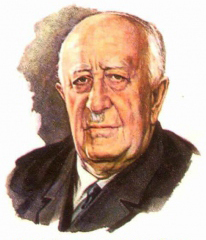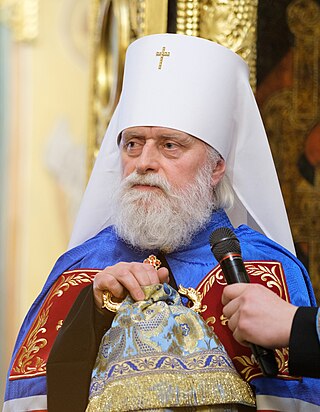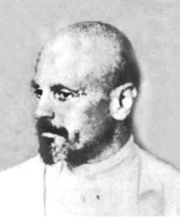
Staraya Ladoga, known as Ladoga until 1704, is a rural locality in Volkhovsky District of Leningrad Oblast, Russia, located on the Volkhov River near Lake Ladoga, 8 kilometers (5.0 mi) north of the town of Volkhov, the administrative center of the district.

Ivan Yakovlevich Bilibin was a Russian illustrator and stage designer who took part in the Mir iskusstva, contributed to the Ballets Russes, co-founded the Union of Russian Artists, and from 1937 was a member of the Artists' Union of the USSR. Ivan Bilibin gained popularity with his illustrations of Russian folk tales and Slavic folklore. Throughout his career he was inspired by the art and culture of medieval Russia.
The Catacomb Church as a collective name labels those representatives of the Russian Orthodox clergy, laity, communities, monasteries, brotherhoods, etc., who for various reasons, moved to an illegal position from the 1920s onwards. In a narrow sense, the term "catacomb church" means not just illegal communities, but communities that rejected subordination to the acting patriarchal locum tenens Metropolitan Sergius (Stragorodsky) after 1927, and that adopted anti-Soviet positions. During the Cold War of 1947-1991 the Russian Orthodox Church Outside of Russia popularized the term in the latter sense, first within the Russian diaspora, and then in the USSR. The expression "True Orthodox church" is synonymous with this latter, narrower sense of "catacomb church".

Vladimir Nikolayevich Sukachev was a Russian geobotanist, engineer, geographer, and corresponding member (1920) and full member (1943) of the USSR Academy of Sciences. His wife was Henrietta Ippolitovna Poplavskaja.
Vladimir Nicolayevich Beneshevich was a Russian scholar of Byzantine history and canon law, and a philologer and paleographer of the manuscripts in that sphere.

Alexander Nikolayevich Samokhvalov was a Soviet Russian painter, watercolorist, graphic artist, illustrator, art teacher and Honored Arts Worker of the RSFSR, who lived and worked in Leningrad. He was a member of the Leningrad branch of Union of Artists of Russian Federation, and was regarded as one of the founders and brightest representatives of the Leningrad school of painting, most famous for his genre and portrait painting.

Dmitri Nikolaevich Bantysh-Kamensky was a Russian statesman and historian who studied under pioneering 18th century historian G. F. Müller He served as Governor of Tobolsk Governorate between March 1825 and 20 July 1828 and then later became Governor of the Vilna Province between May 1836 and 1838. Dmitri Bantysh-Kamensky is considered the first true historian of the Cossacks.

Cafe Gurzuf is a painting by Alexander Nikolayevich Samokhvalov, Russian artist, regarded as one of the founders and brightest representative of the Socialist Realism style. The painting depicts a view of a summer cafe in Gurzuf, Crimea, in the middle of the 1950s.
The year 1963 was marked by many events that left an imprint on the history of Soviet and Russian fine arts.
Ljubov A. Rebane was an Estonian physicist. She graduated from Leningrad University in 1952 and received a PhD in Physics and Mathematics in 1961 from the same university.

Dinar was a Georgian princess of the Bagrationi dynasty of Tao-Klarjeti and Queen regnant of Hereti. She is venerated as a saint. The Georgian Orthodox Church commemorates her on June 30.

Mikhail Mikhailovich Rusinov was a Russian scientist specialising in optics. He co-founded the USSR Science School of Computational Optics and discovered several optical phenomena, including aberration vignetting (1938), projection centre distortion (1957), and existence of second-order aberration (1986). The phenomenon of projection centre distortion became the basis for engineering photometry.

Pyotr Nikolayevich Polevoy was a Russian writer, playwright, translator, critic, editor and literary historian. The prominent journalist and editor Nikolai Polevoy was his father.

Sofia Viktorovna Polyakova was a Soviet classical philologist, Byzantine specialist and scholar of ancient Greek and Byzantine authors. She published the first collection of the works of the Russian poet Sophia Parnok and was the first scholar to unravel the relationship of Parnok and Marina Tsvetaeva. Her work on Parnok, revived scholarly interest in the poet.

Metropolitan Eugene is a bishop of the Russian Orthodox Church, Metropolitan of Tallinn and All Estonia and primate of the Estonian Orthodox Church of the Moscow Patriarchate, former rector of Moscow Theological Academy (1995–2018) and Chairman of the Educational Committee of the Holy Synod (1994–2018). After on January 18, 2024, Estonia announced that it would not renew Reshetnikov's residence permit Reshetnikov left Estonia on February 6, 2024. His residence permit was evoked because he was assessed to be a security risk due to his justification of Russia’s invasion of Ukraine and his defense of the Russian government.
Nikolay Petrovich Krasnikov was active in Soviet academia as a philosopher, historian, and religious scholar.

Archbishop Nestor is Bishop of the Russian Orthodox Church, Archbishop of Madrid and Lisbon.

The Tale of the Destruction of the Russian Land is a text of Old East Slavic literature dating back to the 13th century and known from two manuscripts of the 15th and 16th centuries. It is a reflection on the Mongol invasion of Rus.
Saints in the Russian Orthodox Church are confirmed by canonization which lists the decedent into the Community of Saints. After canonization, the saint is usually listed in the Menologium. The saint is honoured by illustrating him on icons, mentioning him in kondaks or troparions, narrating his achievements in the Lives of Saints, confirming a celebration date in the Orthodox calendar and building churches and monasteries holding his name. The office of canonization is usually the last prayer to the departed and first prayer to the saint.













